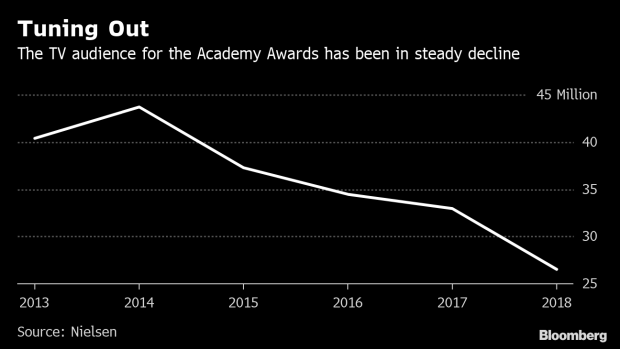Feb 20, 2019
A Snapshot of the Oscars’ Struggle for Relevance
, Bloomberg News

(Bloomberg) -- The Oscars remain a cash cow for Walt Disney Co.’s ABC network and a driver of box-office sales for the movies that get big nominations.
But each year, fewer and fewer people watch the awards ceremony on TV -- and those who do see a room packed with white, male directors and producers.
This year’s awards, which will be broadcast Sunday from the Dolby Theatre in Los Angeles, are an attempt to shake things up. The Academy of Motion Picture Arts & Sciences has tried to make the ceremony more engaging, though it backed away from controversial ideas such as giving out a popular-movie award. The organization also has pushed to diversify its membership.
For the first time in three decades, the Oscars will have no host -- though that wasn’t by design. Kevin Hart stepped down from the role in December after homophobic tweets caused an outcry, and he was never replaced.
One thing is clear: The academy can’t settle for the status quo. Oscar viewership fell 20 percent last year, marking its smallest TV audience in history.
Even with shrinking viewership, ad prices for the program have remained strong. That’s a reflection of how hard it is for marketers to reach a large live audience in today’s fragmented media landscape. ABC is getting $2 million to $2.6 million for every 30-second spot, according to a person with knowledge of the matter.
The network pays about $75 million a year for the rights to broadcast the Oscars. It generated $149 million in advertising revenue from last year’s telecast, an all-time high, according to Kantar Media.
While the Oscars are still lucrative for ABC and the academy, which gets most of its revenue from the broadcast, the event also helps line the pockets of the film studios.
Last year’s best picture winner, “The Shape of Water,” saw its box-office sales rise 10 percent after it won, according to Comscore Inc. “Moonlight” added 21 percent to its gross after taking home the best picture prize the year before. Even just being nominated can bring a sales surge, which is why the studios spend heavily on award-season campaigning.
Look around the room at Hollywood award shows, though, and you might notice something: a lot of white guys. It’s a fact that Natalie Portman spotlighted at the Golden Globes a year ago when she introduced a director award by saying, “Here are the all-male nominees.”
It’s a problem that goes beyond prestige films. Of all the directors whose movies earned at least $250,000 at the box office, just 12 percent were women in 2017, according to the Directors Guild of America. The industry scores even worse on racial equality, with 10 percent of those films directed by a minority, down from 17 percent in 2013, according to the guild.
A woman has only won an Oscar for directing once: Kathryn Bigelow, for “The Hurt Locker.” That same film is also the only female-directed movie in 90-plus years to get a best picture prize.
Finally, Oscar voters’ preference for smaller, art-house films may have contributed to low ratings in recent years.
In the past, blockbuster films like “Titanic” won top Oscars. The more recent winners, such as “Birdman” and “Moonlight,” were more esoteric. The last really big hit to win a best picture award was “The Lord of the Rings: The Return of the King” 15 years ago.
On that front, this year’s awards offer a mixed bag. “Black Panther,” a superhero film that generated more than $1.3 billion, is one of the movies nominated for best picture.
But Netflix Inc.’s “Roma,” a black-and-white film with a limited theatrical release, is favored to win.
To contact the reporters on this story: Gerry Smith in New York at gsmith233@bloomberg.net;Christopher Palmeri in Los Angeles at cpalmeri1@bloomberg.net;Anousha Sakoui in Los Angeles at asakoui@bloomberg.net
To contact the editor responsible for this story: Nick Turner at nturner7@bloomberg.net
©2019 Bloomberg L.P.





